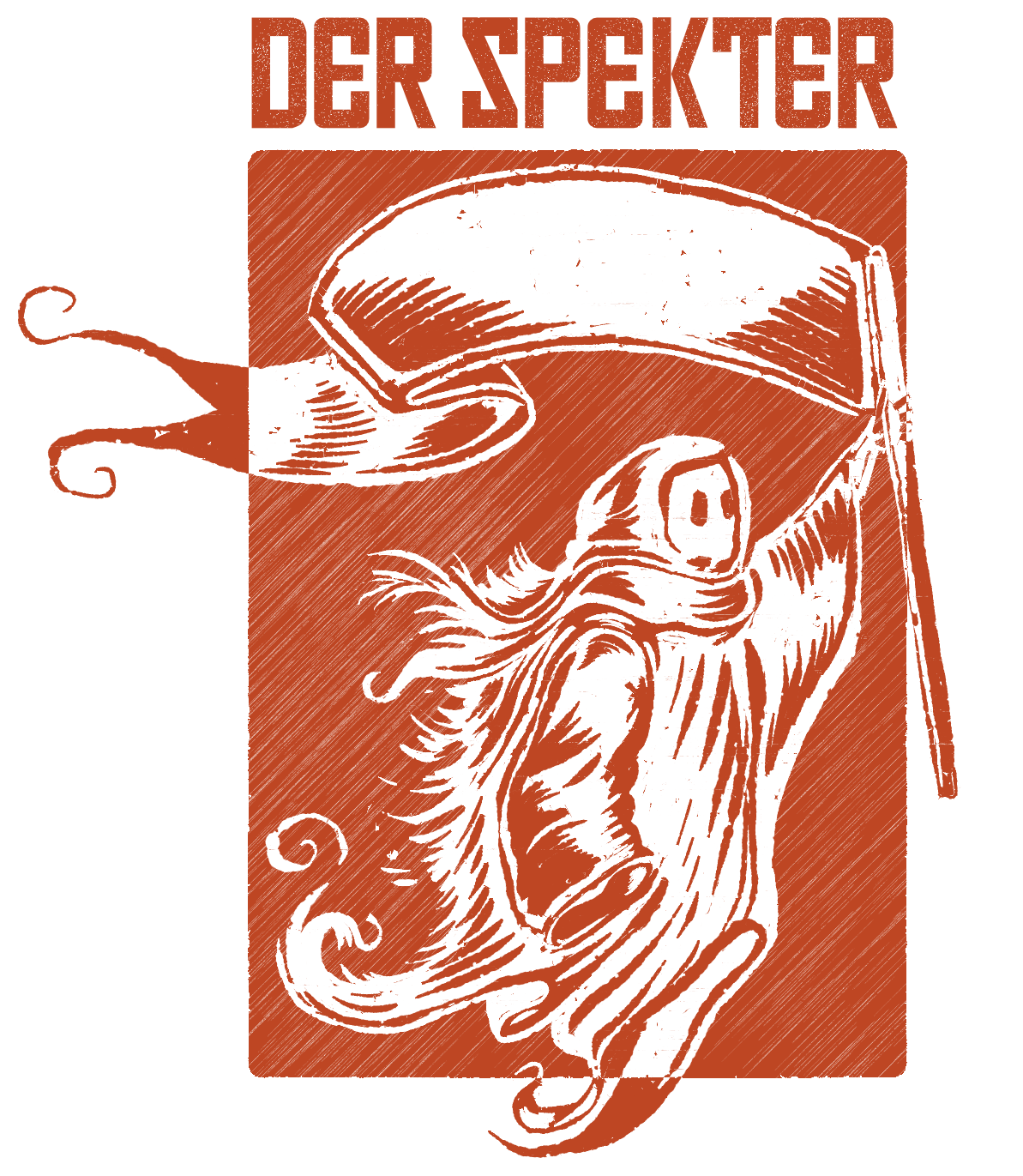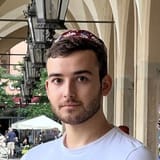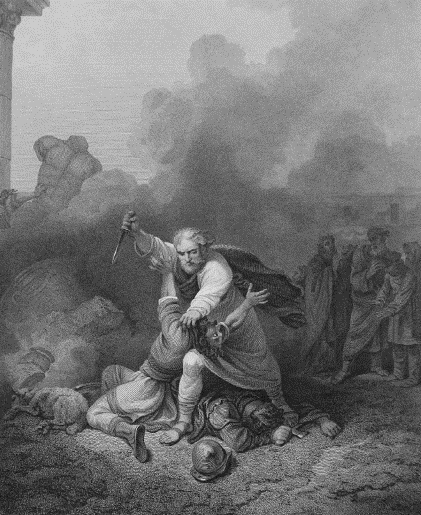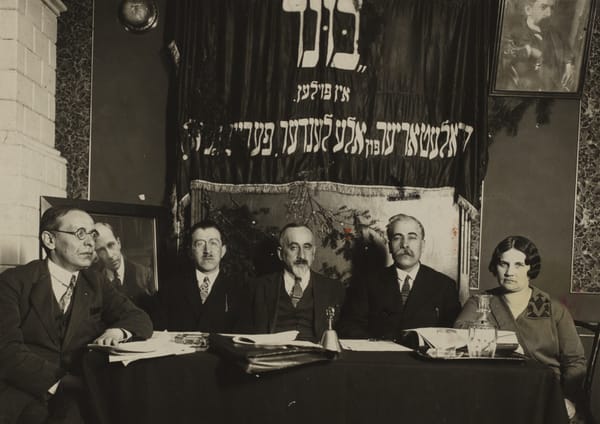Bundism Today, Part 2: Yiddishkeit
The Bundist approach at no real point degenerated into Jewish chauvinism, tribalism, or nationalism. In building an autonomous, non-separatist Jewish force in the labour, environmental, feminist, housing, queer, urbanist, and other socioeconomic liberation movements, we should strive to do the same.
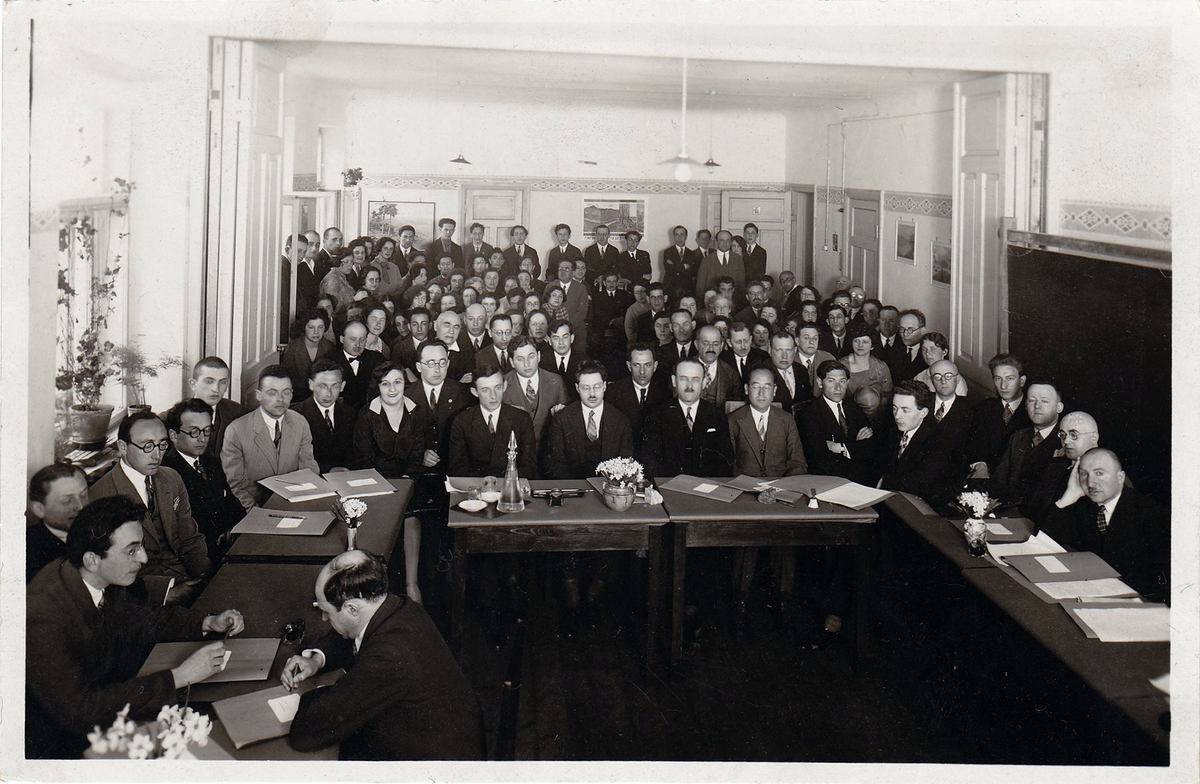
Editor;s note: This is the second part in a series by Zach Smerin — a member of the International Jewish Labor Bund’s Provisional Steering Committee — which Der Spekter will continue to publish in the coming months. Click here for the introduction and part 1 of the series.
Jewish identity, like many other identities, is difficult to conceptualise without grounding it in ideas of Jewish community and the surrounding world. It took me a while to finally decide whether to treat Yiddishkayt and Doikayt separately or together. I ultimately decided to write two essays instead of one, even if I generally feel more confident in discussing Jewishness in a communal setting rather than a personal connection.
What is a Jew?
First things first. For our purposes, it is very useful to differentiate between the terms “Judaism” and “Jewishness.” While the former bases one’s identity on religious practice and customs, Jewishness is more inclusive and could refer to perceiving Jews as a nationality, ethnicity, people, culture, or even other terms such as “civilisation.” I use it interchangeably and attach the same meaning as I do to the Yiddish word “Yiddishkayt,” which literally translates to “Jewishness.”
The diversity of Jewish communities around the world complicates such supposedly simple differentiations. “Yiddishkayt” is clearly connected to the history of the Ashkenazi world. Writers like Melanie Kaye-Kantrowitz have attempted to put the concept in dialogue with other Jewish traditions, but tension in using the Yiddish term, and perhaps even in the English translation, may remain. Additionally, Hasidic Jews will refer to their religious customs and identity as Yiddishkayt, with many viewing an ethnic or cultural Jewish identity separate from religious customs as borderline heretical. Perceiving Jews as an ethnicity does not necessarily mean abandoning the Mosaic faith as a whole, and there is a convenient term for their symbiosis in the term ‘ethnoreligious.’ But what it does mean (and here Bundist thought has shared a certain similarity with Zionist thought) is that customs of religious Judaism are NOT placed as the cornerstone of Jewish identity, without which everything collapses. Such a stance should be able to encompass Jewish communities all over the world.
Nevertheless, such inclusivity will not satisfy everyone. I am not an expert on Halakha, but according to Orthodox interpretations of it, I am not a Jew. Having a Jewish father and a Reform conversion when I was 13, I naturally disagree with this perspective, but the reality is that even if some people are unable to deny your Jewishness by birth or upbringing, they will always find ways to deny it or cast doubt on it by your behaviour — what kind of hat do you wear, what kind of food do you eat, or what kind of ethnostate do you cheerlead.
In the past, this question was made easier by the outside world — even if you didn’t think you were Jewish, the antisemites did, and that sensitivity has survived in certain ways (such as Israel’s law of return and its grandfather clause). However, it is quite possible today, in many countries, for many Jews or people with Jewish backgrounds (though certainly not all) to live fully goyish lives without any goyim in their life having any idea about it in a way that would have been much harder in the past. Are such people Jewish? Is it possible, or even desirable, to try and state whether their Jewishness is stronger or weaker than that of other Jewish people?
The simple truth is that unless you are exclusively concerned with Halakhic interpretation or gross notions of ‘blood purity,’ the only meaningful and inclusive understanding of who is a Jew is based on sincere and grounded self-identification.
How many Jews?
Given such an understanding of Jewishness, the question of “how many Jews are there in X” — a question we in Poland are used to hearing — becomes much more difficult to answer. Thus it becomes more reasonable, though perhaps more complicated, to speak in terms of those people who are active in the community, those who identify as Jews, and those who have Jewish ancestry or background. Which is still, of course, a simplification.
Ask yourselves: of the “official” Jewish population of your town or country, how many are actively involved in the organised mainstream Jewish communal institutions? In many places, chances are that it’s actually a minority, and a small minority at that, if you consider how many people could potentially be interested in joining a Jewish community. The reasons as to why Jews are not active in their local communities obviously come from a wide range of factors, which I’ll explore more in Part 3 (Doikayt), but what matters now is to understand that a wider understanding of Jewishness can reverse much of the mainstream thinking about “vanishing diasporas” or “aging communities” and present a potentially brighter vision of the future than that offered by the status quo.
Nationalism?
But wait a moment — isn’t focusing on the development of the Jewish community, of viewing (at least to some extent) Jewish identity as distinct from other cultures and ethnicities, exemplary of nationalism?
"The Bundist approach, which supported the fostering of Jewish culture on a great scale, at no real point degenerated into Jewish chauvinism, tribalism, or nationalism."
From the early days of the Bund, the idea of a separate Jewish socialist organisation that would advocate for non-territorial national-cultural autonomy for Jews was criticised. It was condemned by Jewish and non-Jewish socialists, reformists, and revolutionaries in Russia, Austria-Hungary, and other countries. The reasons for this lie to a significant extent in the orthodox Marxist position — that Jews are a religious group that should be emancipated and protected from antisemitism, following which Jews would assimilate into the nationalities of the nations they lived in. Any notion to ‘resist’ that supposedly ‘natural’ process was considered to be nationalist, even if the conditions for Jewish workers in Ukraine or Poland were vastly different from those of assimilated Jewish intellectuals in Vienna or Berlin.
More detailed historical accounts on the divides between the Bund and other socialist parties on the “Jewish Question” from a hundred years ago can be found elsewhere. What’s important to me is to respond to the idea that the Bund is “nationalist,” which I have heard on occasion today.
“Nationalism” is best understood, in my opinion, as a worldview in which the nation (which can be defined in ethnic, religious or racial terms) is considered to be the primary factor in understanding human society and divisions within it. As opposed to, for example, class, which is the traditional Marx-informed socialist perspective.
There are two important caveats to that:
- Understanding the primary importance of class in shaping human society doesn’t mean that other forms of social division and hierarchy are ignored (which would be a class reductionist approach).
- Since socialist movements have largely organised around specific national or ethnic groups, a socialist movement can act as a national liberation movement without being nationalist.
Under this understanding of nationalism, would it be appropriate to classify the Bund as “nationalist”? Not in the slightest. The Bund always classified itself as the Jewish section of the labour and socialist movement in the countries in which it organised (not as a global Jewish movement, mind you). It cooperated with other socialist parties and organisations. The fact that the Bund functioned as an independent party after 1903, rather than as an autonomous organisation within a Polish or Russian socialist movement, had more to do with the non-Jewish movements being unwilling to accept the demand for national-cultural autonomy (with antisemitism not an insignificant factor) than with the Bund itself. In this regard, the Socialist Workers Federation in Salonica, with its Sephardic, Turkish, Greek and Bulgarian sections, succeeded where the Bund did not.
The Bund’s vision of national cultural autonomy was based on voluntary self-identification. It never entered into a grand coalition of Jewish organisations simply because they were Jewish, even at times of high antisemitism. (The only exception was during the Warsaw Ghetto Uprising, and even then it was primarily with Socialist Zionists, and after much debate). Several instances indicate how the Bund resisted the temptation to portray its struggle as “Jew vs. Gentile.” Its criticism of Zionism, particularly the far-right revisionist Zionism of Jabotinsky that is dominant in Israel today, emphasised that (Jewish) nationalism was not made any better just because Jews were being ruthlessly oppressed:
“No, we are not a chosen people. Our nationalism is just as ugly, just as harmful, and has the same inclination to fascist debauchery as the nationalisms of all the other nations.”
Bundist self-defence squads that protected Warsaw’s Jewish merchants from right-wing Polish thugs refused to take payment from those they defended — their struggle was against fascism, not Poles. During WW2, Bundist youth in Warsaw eulogised Koloman Wallisch, a martyred Austrian socialist, while Austrian SS-men surrounded the Ghetto walls. After the war, the Bund took a nuanced stand towards reintegrating the German Social Democrats into the global socialist movement, which the latter appreciated.
We can thus see that the Bundist approach, which supported the fostering of Jewish culture on a great scale, at no real point degenerated into Jewish chauvinism, tribalism, or nationalism. In building an autonomous, non-separatist Jewish force in the labour, environmental, feminist, housing, queer, urbanist, and other socioeconomic liberation movements, we should strive to do the same.
Jewish Values
The question of whether Jewish leftists should appeal to “Jewish values” in their activism or rather to humanist notions of social justice or collective liberation is one that has been a subject of discussion in both the British and American contexts in recent years. From the traditional Bundist perspective, if you were to look through all the publications of the movement from the early years of the 20th century, you’d probably have a very difficult time finding any mentions of “Tikkun Olam” or “Tzedek Tzedek Tirdof.” They wouldn’t aim to validate their worldview through Pirkei Avot 2:16. As a largely atheistic, staunchly anti-clerical movement, the Bund viewed Jews as a people primarily through a national perspective, not a religious one.
In our current organising climate, particularly in the United States, many Jewish non- or anti-Zionist groups are rooted in spiritual community or draw inspiration from it. Ironically, this can lead to a Hebrew-centred Jewish vocabulary, as in the aforementioned examples.
Is there a way to square this circle between universal and Jewish values, with the latter often drawing on religious traditions? Given that many of us who are interested in revitalising the Bund are deeply connected with such spaces, I believe that the answer lies in a few caveats:
First of all, no one has a monopoly of what the values of a culture/community are, and to even suggest that a group consisting of millions of people has certain ‘true’ values is already highly generalising. Rather, it is easier to argue that there are certain historical progressive and emancipatory Jewish traditions that we feel connected to and can draw inspiration from.
Secondly, feeling connected to values stemming from certain Jewish traditions does not mean that our values are deemed superior to the values of other groups. Whether it be a line of the Talmud or a quote from a Bundist organiser, these can simply be understood as Jewish versions of universal human values that other cultures and communities also resonate with from their own internal sources. And of course, cultures interact constantly, so the notion that certain values can strictly be claimed as ‘originating from’ any individual group is frequently highly suspect.
I am also quite sceptical of the voices calling for the abandonment of the “Jewish values” rhetoric, especially if the alternative is a universalist perspective that does not recognise Jews as a marginalised group that deserves to be a coalition partner in liberation struggles, not simply as an ally who is in a position of socioeconomic superiority. I will go into more detail on this in part 4 (Khavershaft).
Lastly, despite my personal upbringing and beliefs, I am personally sympathetic to those religious/spiritual Jews who seek to draw on their own traditions in their activism. Even in the interwar period, religious members of the Bund and the Tsukunft organisation were generally tolerated for their beliefs. Esther Frumkin, one of the early female leaders of the Bund, openly spoke about her sentimental attachment to lighting the Shabbes candles. There is no particular reason as to why Bundists today shouldn’t be openly religious or build religious community within the movement. However, I believe that such efforts should be done in cooperation with a more general focus of the Bund fighting cultural poverty within the Jewish community and a modern secular Jewish cultural identity.
Secular Jewish Culture
The notion of identifying as “culturally Jewish” in 21st-century America is often imagined to be a statement of defensive insecurity about one’s Jewish identity. For people who are not religiously practicing or are uneducated on religious customs, it can serve as a kind of protective shield against accusations of not being “really Jewish.” Atheist or non-practicing Jews who desire connection to mainstream Jewish communities might therefore turn to Zionism, or the associated secular Israeli identity, and be protected from accusations of being a “fake Jew.” But for those who don’t subscribe to that, options for Jewish cultural identity may be limited, while accusations of being a fake Jew/Jew In Name Only (JINO)/token Jew/Asajew may be plentiful.
For what it’s worth, Bundists were usually spared similar accusations by their Zionist critics. But this was in a time when being Jewish generally meant significant segregation from general society. In contrast, Jewish non-Hasidic diasporic communities are today largely integrated, with many more Jews and people with Jewish backgrounds completely assimilated. Is a distinct Jewish non-religious identity viable in such conditions?
There has been some talk in recent years about the ideas of Jews ‘de-integrating’ or ‘de-assimilating’ in the diaspora. Labels aside, I feel it important to stress that under no circumstances would I advocate putting pressure on people with Jewish backgrounds to identify as Jewish, and certainly not as part of building a Jewish political movement. It is an extremely personal decision that one has the full right to hesitate on, vacillate on, and go back and forth on, however long one may see fit.
But for those of us who accept our Jewishness, whether with an element of pride or simply as a matter of fact, and who wish to organise as Bundists, the importance of nurturing a vibrant and thriving secular Jewish culture in all its diversity, is paramount, be it through music, film, art, fashion, theatre, literature, sport, opera, food, dance, or anything else.
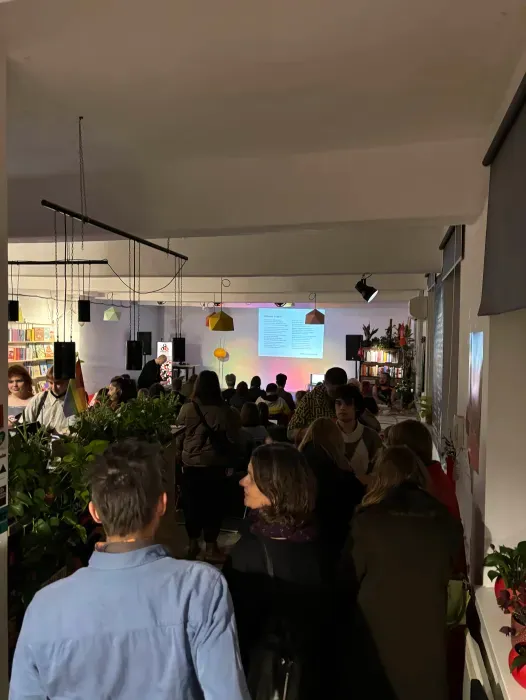

Left: Cafe Bund hosts a Yiddish leftist Shabbes musical night with the Kraków Revolutionary Choir and DJ Chaia, November 2024. Right: A Cafe Bund Shabbes Dinner, July 2024. Photos courtesy Zach Smerin.
Such an understanding of Jewish culture is “secular” in the sense that its relevance is not dictated by whether it is based on religiosity or not. Furthermore, it should strive to be rooted in everyday life, not simply relegated to annual festivals or “folk” traditionalism. It certainly takes inspiration from the latter but is not trapped in rigid conceptions of what culture “should be.” Instead, it recognises that Jewish culture is a continuously evolving projection of the Jewish people of its time. Of course, this will lead to divisions — what is subsidised, encouraged and produced will often be dependent on wealth and prestige. Cultural production for the common good that isn’t driven by profit or elite patronage carries almost by its nature significant anti-capitalist undertones, and it’s certainly worth tapping into them.
It may be tempting to add a point here that cultural activities that easily fit into mainstream Zionist narratives will find more institutional support than those that don’t. And while this is true to a certain extent, it doesn’t tell the full story. The sad reality is that in 2025, many Jewish diaspora communities find themselves in a state of cultural poverty. It isn’t so much that the Jewish population finds itself under a constant barrage of cultural propaganda; it’s rather that, through the very limited amount of cultural activities, many people feel their connection to Jewishness can only come through the relative vibrancy of mainstream Israeli culture.
I remember when I started getting involved with the Jewish student community at my university in Britain. Apart from my political differences with many of my peers, what struck me most was the lack of any sort of systematic engagement and nourishment of Jewish culture in any form. The only regular ‘Jewish’ meals, at the weekly Friday Night Dinners, present almost every time were falafel, hummus, chicken soup, and Israeli salad. At parties, basically the only Jewish songs were Israeli pop. There’s nothing wrong with any of these in and of themselves — but if these are the only forms of Jewish culture available in your community, I’d call that a bit…reductive. A Jewish language course, book club, choir, theatre troupe dance class, group for educational talks (it’s a university!) — none of these possibilities were discussed in any meaningful way. While this is only one university with a medium-sized Jewish student community, further experiences with other Jewish student societies at a local and national level lead me to believe that this is an institutional problem, deriving from the mainstream educational opportunities currently available for Jewish children in Britain and inevitably transferring to the adult community down the line.
Such a framework makes it easier to understand the depth of connection with Israel for Jews who don’t have direct family connections there or who don’t derive their Jewish identity from religious practice. Even without having a particularly nationalist worldview or believing in Israel as a safe haven for Jews, secular Israeli Jewish culture can anchor confidence in one's Jewishness when lacking alternatives.
There is absolutely no evidence to suggest some conspiracy among our communal establishment to deny us a vibrant diasporic culture. Aside from the antisemitic undertones of such an assertion, the reality is much more easily explained through a combination of linguistic assimilation (since in the Ashkenazi world, much Jewish culture was historically connected to Yiddish) and general neoliberalism and social atomisation. Even taking into account some extent of Zionist diaspora negationism, what matters most is that we, who believe in a vibrant Jewishness in the Diaspora, take the initiative and force the mainstream to answer why such cultural poverty has been allowed to fester for so long.
Our task, then, should be to support all forms of cultural nourishment, in all its diversity, without simply resorting to a purist approach that perfectly toes a Bundist or anti-Zionist line. In the interwar period, Bundist publications served as mediums for publication for “apolitical” literature, particularly for new writers, with the attitude being that as long as it wasn’t explicitly against the Bund, it was good to publish. We should do the same, since the decline of cultural poverty in our communities will create better conditions for Bundist organising — and is to the benefit of Diaspora Jewry as a whole.
Yiddish
As mentioned already, one of the most crucial forms of Jewish culture for the Bund was the popularisation of Yiddish. Aside from the mutual aid organisations and unions that developed the Jewish labour movement in the 1890s (mentioned in Part 1), the Bund developed out of a realisation by Jewish and non-Jewish Russian revolutionaries that workers and craftsmen in the multilingual empire should be communicated with in their own language. Based on this initial principle, the Bund became critical in the movement to recognise Yiddish as a fully fledged language with a great potential for cultural vibrancy — not a bastardised plebeian dialect of German, as Herzl and others like him believed. In the Bundist view, while Zionists obsessed over reviving an ancient biblical language – Hebrew – as part of a nationalist fever dream, Yiddish was the common language of the working Jewish masses of Eastern Europe.
"As part of the fight for a vibrant and diverse Jewish cultural life, the movement should support the revitalisation of Yiddish, as well as other Jewish diasporic languages. Everything I say about Yiddish applies just as much to other Jewish diasporic languages, including Bukhari, Ladino, Judeo-Arabic languages, and others."
Yiddish is no longer the common language of Jewish working masses anywhere. Even in many sections of the Hasidic community, modern Hebrew has a much stronger claim to being the lingua franca of the Jewish people, if one needed to be chosen. Historical circumstances that led us to this situation notwithstanding, where does this leave Bundists?
The primary language of Bundist organising will have to remain English for the foreseeable future, with local groups and chapters using their own local languages in countries where English isn’t the main language. However, given the movement’s history and the cultural legacy lost to assimilation in the diaspora and in the State of Israel, as part of the fight for a vibrant and diverse Jewish cultural life, the movement should support the revitalisation of Yiddish, as well as other Jewish diasporic languages. Everything I say about Yiddish applies just as much to other Jewish diasporic languages, including Bukhari, Ladino, Judeo-Arabic languages, and others. I focus on Yiddish for personal reasons, but for many Jews with origins in the Middle East and North Africa, a renewed connection to their ancestry may be an important part of developing a brighter future for the region.
To support Yiddish is to build on the substantial cultural and academic work of Yiddishists of the last few decades all over the world. There are too many great examples to list here, but I am personally particularly fond of the Yiddish Open Mic Cafe format developed in England in the last few years. It manages to square the circle between a space where all creative work is conducted in Yiddish while also being fully accessible to people who don’t know a single word of the language. More Yiddishist projects are currently underway.
However, there is a current paradoxical limitation on what has been accomplished so far. While the interpersonal connections in the secular Yiddishist world are very strong (the joke being that every secular Yiddishist is at most one degree away from knowing every other secular Yiddishist), the institutional connections are very weak. Far from being transnationally organised, existing Yiddishist projects and institutions in Australia, Britain, France, Austria, Poland, Germany, Sweden, Israel, Canada, the United States, and other countries have not developed a forum in order to exchange ideas (Yiddish media!), develop ambitious and complicated projects (a primarily Yiddish school curriculum, for example) and raise funds within the Jewish community (so that Yiddish language courses aren’t so damn expensive).
Such Yiddishist coalitions have existed in the not-too-distant past but can be traced back as far as the 1908 Czernowitz Conference — the first organised political attempt to organise Yiddishists. And of course, Bundists played an important role in these efforts, such as the World Congress for Jewish Culture, YIVO, and the Kultur-Lige. In the last-mentioned, they were a driving political force. This is particularly important today, since many Yiddishist spaces declare themselves apolitical, both as a means of protecting funding and being inclusive for everyone.
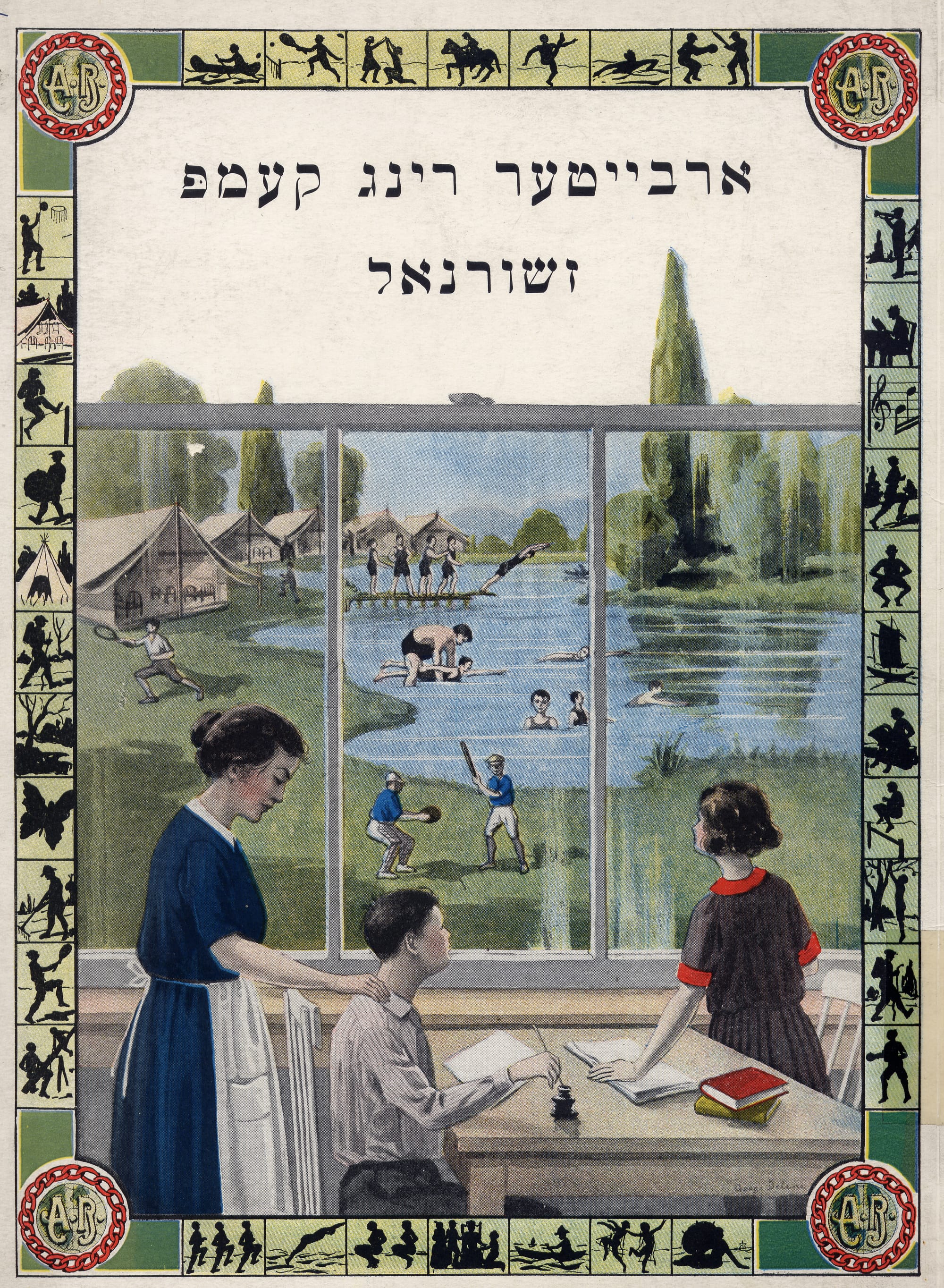
Inasmuch as this may be frustrating for leftists, I can understand the case for keeping Yiddish accessible to a general audience if the institutions are already quite small. It’s something that can be addressed by developing more explicitly leftist Yiddishist spaces while developing a Bundist presence in general Yiddishist institutions. The fact of the matter is that while having a local Yiddish cultural centre will not necessarily be treated as ‘political’ by the Jewish establishment, fighting for the rights of Jewish kids to learn Yiddish at Jewish school is political. And given our current strength, resources, and potential appeal, it is necessary to organise and push general Yiddishist institutions in this direction for the benefit of the language as a whole.
What does a ‘revitalisation of Yiddish’ mean, ultimately? While we shouldn’t be blinded by historical nostalgia, I think we can imagine a future where Yiddish, along with other Jewish languages, is part of a vibrant linguistic tapestry within our community at a global and local level.
It means that in a neighbourhood where it is expected to find a kosher supermarket, a Chabad, a Jewish school, a synagogue, a mikveh, or a JCC, you also have a comfortable physical space where you can walk in and expect to be able to speak Yiddish with someone, where you know other Yiddishists will be hanging out, where regular events in and about Yiddish are held frequently, and where you can easily access diverse new Yiddish media.
It means that everyone is able to learn Yiddish if they want to, regardless of income, whether they are 7, 17, or 70 years old, and no one will ask them who they are going to speak it with.
It means that a vibrant global community can continue to develop with the benefit of instant online communication and online resources, and that some Jews, at least, have another transnational lingua franca besides English and Hebrew, and that everyone who wants to travel to meet other Yiddishists at conferences or retreats can do so.
It means that there are both funds and audiences for new Yiddish literature, film, theatre, music and other media. In some countries, like Sweden or Poland, national minority language laws give us unique opportunities to begin this work in the near future, with the latter country severely lacking in comparison to the former.
It means a potential new way to connect with Hasidic communities, at least at the interpersonal level on the ground. After all, many of them are practicing Yiddishists. This will help us move beyond the “shrinking community-rising orthodoxy” dichotomy and maybe even develop a new understanding of what Jewishness means, in all its diversity, in the 21st century.
